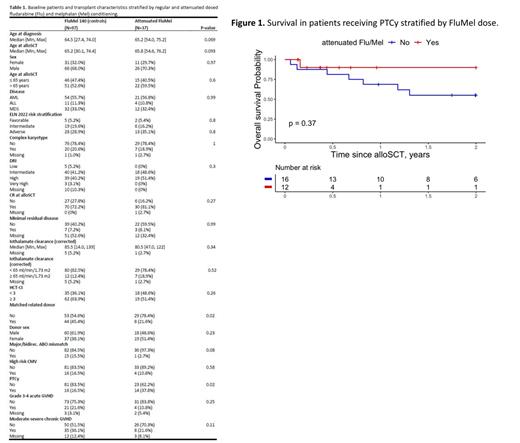Introduction: Fludarabine combined with melphalan 140 mg/m2 (FluMel140) is a commonly used reduced-intensity conditioning (RIC) regimen in patients undergoing matched related (MRD) and unrelated donor (MUD) allogeneic stem cell transplant (alloSCT). Ciurea et al Blood 2020, described outcomes of Flu 160 mg/m2 and Mel 100 mg/m2. In this study, we describe our experience of attenuated melphalan dosing 100-120 mg/m2 versus 140 mg/m2 with fludarabine 125 mg/m2 (attenuated FluMel versus regular dose FluMel).
Methods: We retrospectively reviewed patients from November 2016 to April 2023 with AML, ALL or MDS undergoing alloSCT who received fludarabine and melphalan. Patients who received the lower dose of melphalan were considered to be the attenuated FluMel cohort, whereas patients receiving the melphalan 140 mg/m2 were considered to be the control cohort. Kaplan-Meier and log-rank tests were used to estimate OS. NRM and relapse incidence (RI) was calculated using competing risk analysis. R 4.2.0 (R Foundation for Statistical Computing) was used for statistical analyses.
Results: A total of 134 patients [92 (68.7%) males] were evaluated. Thirty-seven (27.6%) patients received attenuated FluMel and 97 (72.4%) patients received regular dose FluMel (controls). Among the patients in the attenuated FluMel cohort, 5 (13.5%) patients also received fludarabine at doses less than 125 mg/m 2 [median 20 mg/m 2 (range 87.5-112.5 mg/m 2]. Median age at transplant was 65 years (range 30 - 76 years). The most common disease was AML [75 (56.0%) patients] ( Table 1). Patients in the attenuated FluMel group had comparable iothalamate clearance compared to control cohort (clearance <65 ml/min/1.73 m2: 18.9% vs. 12.4%, P = 0.52). Patients in the attenuated FluMel group had comparable rates of high/very high DRI to those in control cohort (51.4% vs. 43.3%, P = 0.91). Compared to the control cohort, patients in the attenuated FluMel group were less likely to have a matched related donor (21.6% vs. 45.4%, P = 0.02) and were more likely to receive PTCy for GVHD prophylaxis (37.8% vs. 16.5%, P = 0.02).
Among the patients receiving attenuated FluMel, the median melphalan dose administered was 100 mg/m2. The median time to neutrophil engraftment was 19 days (IQR 16-21 days), and median time to platelet engraftment was 18 days (range 12-25 days). Eleven (29.7%) patients developed post-alloSCT mucositis, and 3 (8.1%) patients developed grade 3-4 mucositis. All the patients in the attenuated FluMel group achieved 100% CD33 donor chimerism at day +30 (n=35) and day +100 (n=28) after alloSCT. Similarly, 26 (74.3%, n = 35) patients achieved ≥ 95% CD3 donor chimerism at day +30 after alloSCT and 23 (82.1%, n = 28) patients achieved ≥ 95% CD3 donor chimerism at day +100 after alloSCT.
Median follow-up of the entire cohort after alloSCT was 2.3 years (95% CI 2.1-2.5 years). Median follow-up was 1.5 years in the attenuated FluMel cohort and 2.5 years for the control cohort ( P<0.001) . Survival was similar among patients receiving attenuated FluMel vs. control cohort (2-year OS 74.7% vs. 65.0%, P = 0.28). At 2 years post-alloSCT, the attenuated FluMel and control cohort had similar non-relapse mortality (19.9% vs. 24.4%, P=0.58) and relapse (22% vs. 15.2%, P=0.51). The attenuated FluMel was not associated with an increased incidence of relapse (HR 1.36, 95% CI 0.50-3.73, P=0.55) or NRM (HR 0.74, 95% CI 0.28-1.95, P = 0.55). GVHD-free relapse free (GRFS) survival was also similar among the attenuated Flu/Mel and control cohort (1-year GRFS rate 41.1% vs. 45.6%, P = 0.8).
Among the patients receiving PTCy for GVHD prophylaxis, the 2-year OS in patients receiving attenuated FluMel was higher than the control group, but it was not statistically significant (2-year OS rate: 90% vs. 55%, P=0.37, Figure 1). Compared to the control group, the attenuated FluMel group had similar rates of NRM at 100 days (10% vs. 12.5%), 1 year (NA vs. 25%) and at 2 years after alloSCT (NA vs. 25%, P=0.54). GRFS at 1 year was also similar between the attenuated FluMel and control group (68.6% vs. 43.8%, P = 0.69).
Conclusion: The attenuated dosed FluMel conditioning is a safe and effective regimen for elderly patients with acute leukemia and MDS, and is non-inferior to regular dose FluMel. Among patients receiving PTCy for GVHD prophylaxis, the lower dose of melphalan was non-inferior to regular dose FluMel for survival outcomes. Larger studies are needed to confirm our findings.
Disclosures
Baranwal:Cancer Centers of Southwest Oklahoma: Current Employment. Shah:AbbVie: Research Funding; Astellas: Research Funding; MRKR Therapeutics: Research Funding; Celgene: Research Funding. Alkhateeb:Mayo Clinic: Current Employment.


This feature is available to Subscribers Only
Sign In or Create an Account Close Modal